- Submissions

Full Text
Associative Journal of Health Sciences
Emotional Intelligence Among Undergraduate Medical Students at University Of Baghdad
Qahtan Q Mohammed1 and Adnan Y Mohammed2*
1Department of Psychiatric and Mental Health Nursing Department, Iraq
2Psychiatrist, Ministry of Health, Iraq
*Corresponding author: Adnan Y Mohammed, Psychiatrist, Ministry of Health, Iraq
Submission: January 02, 2020;Published: March 13, 2020

ISSN:2690-9707 Volume1 Issue2
Abstract
Objectives: The study aims to assess the level emotional intelligence among undergraduate medical students and to identify the relationship between the level of emotional intelligence and some demographic variables of the students such as: academic year, gender, residency, and monthly income.
Methodology: A descriptive, cross-sectional design that is initiated for the period of January 1st to May 1st, 2018 on a sample consisted of [200] students which was selected by convenient sampling method from four medical colleges at University of Baghdad that are: College of medicine, college of dental medicine, college of pharmacy, and college of nursing. The questionnaire is designed and adopted which consists of two parts; the first part is contained the covering letter and the demographic variable of the students and the second part is concerned with Emotional Intelligence Scale [EIS]. The data have been collected through the utilization of the self-administrative report as a mean of data collection and analyzed by application of statistical package for social science IBM SPSS [v. 24]
Results: The result referred that student are showing moderate level of emotional intelligence [63.5%]. There is significant relationship between emotional intelligence with students’ gender, while there are no significant relationships between emotional with academic year, residency, and monthly income.
Conclusion: The study concluded that students at medical colleges group are emotionally stable and emotionally intelligent. There is difference in gender of students with regard to emotional intelligence.
Recommendation: The study recommended for conducting future related studies with various variables and re-conducting the study on a large sample and different specialties is necessary.
Keywords: Emotional intelligence; Medical students
Introductions
Emotional Intelligence [EI], also called as “Emotional Quotient [EQ]”, is one of the most important issues that psychology professionals are concerned with. EI is defined as “the person capability to make sense, control, and react according to their emotions” [1] Originally, emotional intelligence was recognized as rooted in the concept of social intelligence [2-4]. More recent, studies provided evidence that the two concepts really defined interrelated components of the same construct [3]. Next, this wide construct was accurately referred to as “emotional-social intelligence” [5]. Emotional intelligence refers to the human ability of emotional functioning that includes recognizing, remembering, describing, identifying learning, and feeling, using, communicating, managing, understanding and explaining emotions [6]. This emotional information guides in thinking and behavior [7]. Emotional intelligence has an important role in individuals’ life and success which is considered as the ability of individuals to manage their emotions and feelings [8]. Recently, emotional intelligence has become widespread and applied in various fields such as: career, education, and personal development [9,10].
All over the world, individuals are experiencing various emotional experiences, some of them positive and the other negative such as: love, affection, spite and hatred, sad and happiness, anger and fear, etc. all of these emotional experiences have important role in persons’ life because it affect the mental health. Emotional experiences that have been felt by persons are the outcomes of assessment information which include cognitive or received information processing environment, body, memory, to be given react to special practices and conceive action result that could be received from emotional mode [11].
The individuals that develop their emotional intelligence can become productive and successful at what they do, and they help others to become more productive and successful also [12]. It is helpful to evaluate emotional intelligence within organization [13]. It is expected that undergraduate medical students to be emotionally stable, empathetic to patients, good in advising and counselling the distressed relatives, and a good relations manager with leadership [14]. Recently, the world emotional intelligence is started getting associated with medical profession [15]. Emotional intelligence is related to characteristics of the students and their performance at medical colleges, to that a little research have been conducted. Precisely to state that emotional intelligence helps the individual to use his/her capacities, or skills by which he/she can manage themselves, their life, works and other [16].
Focusing on medical professions, especially nursing and medicine are related with a lot of social demands and stress. Hence, the students in these fields need to cope with various stressors of workload and burden from clinical practices during their education [17]. These coping abilities require a good mental health. Therefore, the researcher is focusing on the assessment of emotional intelligence as moderator for mental health and to provide a knowledge base for the future researches in this field.
Objectives of the Study
The present study aims to assess the level emotional intelligence among undergraduate medical students as moderator to mental health and to identify the relationship between the level of emotional intelligence and some demographic variables of the students such as: academic year, gender, residency, and monthly income.
Methodology
The design of the study is descriptive, cross-sectional design that is initiated for the period of January 1st to May 1st, 2018; an assessment approach is applied in order to achieve the earlier stated objectives. The ethical consideration of research is achieved by obtaining the agreement from the Committee of Research Ethics at College of Nursing, University of Baghdad. In addition, the agreements of the students were asked for participation in research by filling the participation consent in covering letter of the questionnaire. For the purpose of administrative and arrangements issues for conducting the research, the permission was asked from the Deanship of medical colleges involved in current study. The permission facilitates the entrance of researcher to the colleges and meeting the students. The setting of the study includes four colleges of medical group at university of Baghdad that are: College of Medicine, College of Dentist Medicine, College of Pharmacy, and College of Nursing.
The sample of the study includes (200) undergraduate students who are studying at the medical colleges that mentioned above, the researcher used the convenient sampling method [non-probability sample] in which the students were selected purposively. For the purpose of sample representation, the researcher select from each college (50) students. According to Soper [18], the sample size that must achieve the parameters of anticipated effect size of 0.15, the desired statistical power level of 0.80, one predictor, and a probability level of 0.05; the minimum required sample size would be 54.
The questionnaire of the study is designed by researcher which consists of two parts; the first part is contained the covering letter and the demographic variable of the students that are: college, gender, residence, and monthly income; the second part is concerned with Emotional Intelligence Scale (EIS). EIS was adopted [19] and used for the current study. EIS is consisted of (41) items that cover the emotional intelligence components which represented by four domains in the scale that are: empathy [represented by items 1-12), emotion regulation (represented by items 13-22), interpersonal relationship management (represented by items 23-33), and selfmanagement (represented by items 34- 41). Each item in the scale was rated into five Likert scale and scored as follow: always (5), almost (4), sometimes (3), rarely (2), Never (1), except the items numbered 16, 18, 20, 21, 22, 36, 37, 38, 40, and 41 that have reverse scores. The emotional intelligence level was estimated by calculating the cut off points for the total mean of scores for the scale which is rated into three levels and scores as follow: low= 41- 95, moderate= 96-150, and high= 151-205.
The original validity for EIS was estimated by content validity method through seven experts in educational psychology which met the acceptance degree of (80%) for the scale items. The original reliability of EIS was achieved by application of Alpha Correlation Coefficient and through method of internal consistency, the reliability results were accepted for all domains of the scale (r= 0.79, 0.82, 0.70, and 0.74). [19] The data have been collected through the utilization of the self-administrative report as a mean of data collection. The questionnaire was distributed after being willing to answer the questionnaire and participate in the study. Statistical analyses were conducted by using statistical package for social science (IBM SPSS Statistics) version 24.0. Data analysis was employed through the application of descriptive and inferential statistical approaches to achieve the objectives of the study.
Result
Table 1 shows that (44.5%) of the students are from fourth academic years, who are female students [69.5%]. Regarding residence variable, the finding shows that more than half of the students are resident in upper class neighborhood (53.5%). The monthly income variable indicates that more of the students report enough monthly income (73%). Table 2 indicates that student is showing moderate level of emotional intelligence (overall: moderate=63.5%). Regarding the domains of emotional intelligence, they show high empathy (82%), moderate emotional regulation (56%), high interpersonal relationship management (81%), and moderate self-management (85%). Table 3 indicates that there is no significant relationship between emotional intelligence among students with their academic year at p-value≤0.05. Table 4 shows that there is significant relationship between emotional intelligence among students with their gender at p-value≤0.05. Table 5 indicates that there is no significant relationship between emotional intelligence among students with their residence at p-value≤0.05. Table 6 indicates that there is no significant relationship between emotional intelligence among students with their monthly income at p-value≤0.05.
Table 1: FDistribution of Sample according to their Demographic Characteristics.
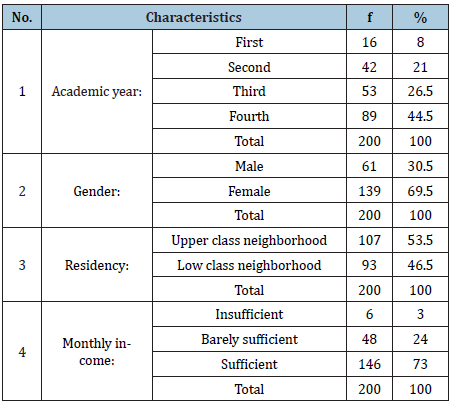
No: Number; f: Frequency; %: Percentage
Table 2: Levels of emotional Intelligence among the Students (N=200).

f: Frequency; %: Percentage; M.S: Mean of score; SD: Standard deviation; *Low= 12-28, Moderate= 29-40, High= 41- 60; **Low= 11-25, Moderate= 26-37, High= 38-55; ***Low= 8-19, Moderate= 20-31, High= 32-40; **** Low= 41-95; Moderate: 96-150: High: 151-205
Table 3: Significant Difference between Emotional Intelligence and Academic Year among the Students (N=200).
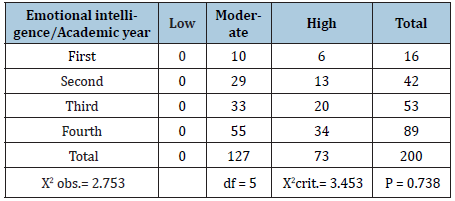
df: Degree of freedom; P: Probability level (P-value≤0.05); χ2 obs: Calculated Chi-square; χ2 crit.: Tabulated Chi-square
Table 4: Significant Difference between Emotional Intelligence and Students’ Gender (N=200).
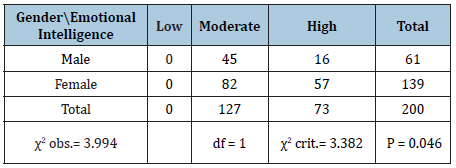
df: Degree of freedom; P: Probability level (P-value≤0.05); χ2 obs: Calculated Chi-square; χ2 crit.: Tabulated Chi-square
Table 5: Significant Difference between Emotional Intelligence and Students’ Residency (N=200).
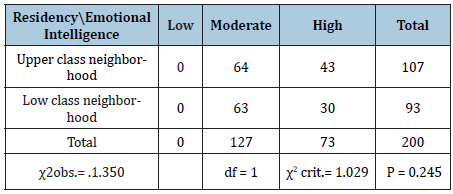
df: Degree of freedom; P: Probability level (P-value≤0.05); χ2 obs: Calculated Chi-square; χ2 crit.: Tabulated Chi-square
Table 6: FSignificant Difference between Emotional Intelligence and Monthly Income among the Students (N=200).
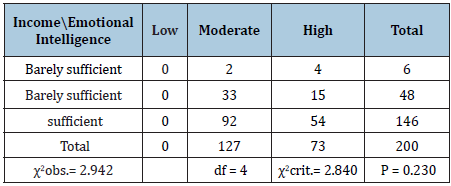
df: Degree of freedom; P: Probability level (P-value≤0.05); χ2 obs: Calculated Chi-square; χ2 crit.: Tabulated Chi-square
Discussion
The analysis of findings in Table 1 presented that students were females in fourth academic year who resident in upper class neighborhood with enough monthly income. The finding related to academic year may refer that the students in other classes are busy in the schedule of practical training. So, most of their presence is in the areas of clinical training which contribute that more of the sample is in the fourth academic year. The gender-related finding which indicates that most of the students are females may be attributed to the large number of females that registered in medical colleges in which the last statistics about University of Baghdad for the years (2017) and (2018) refers that the number of females students are exceeds the number of male students [20]. Regarding residency and monthly income results, the researcher sees that high-income families often have better chances for obtaining good education for their sons and daughters, considering that medical colleges group is the highest among other colleges in Iraq. On the other hand, the registration in these colleges requires more costs to meet the requirement of the study. A study found close finding for this study that medical students are associated with average socioeconomic status [21].
It has been known out of Table 2 that students showing moderate level of emotional intelligence as indicated by the overall score; the emotional intelligence sub-domains refer that the students are highly empathetic and management for interpersonal relationship, while they showing moderate emotional regulation and selfmanagement. The finding of emotional intelligence may indicate that students have an emotional maturity and stability that enable them to manage their relationship, evaluate and regulate their emotions. Such finding is depicting with the researcher’s hypothesis that students at medical colleges having good emotional intelligence. The researcher believes that this emotional maturity is developed among students based on many factors, one of the more important is the nature of the study in these colleges that characterized by their scientific and qualitative content of curriculum that include submission of the students to training and educational programs which requires the student to have personality traits enable him to deal with faculties, other students, and even patients in the clinical area. A study found supportive evidence for this study that found Ozlu et al. [22] who reports that students are showing moderate level of emotional intelligence [22]. Many studies also revealed that students who are studying at colleges of health care specialties are showing high scores of emotional intelligences than others [23,24].
Table [3] indicated that there is no significant relationship between emotional intelligence and academic year among the students. This finding may reveal that students among all classes of academic years have the same emotional stability and the emotional intelligence has not influenced by students’ age group which may be closed with no apparent differences. The current study finding was controversy to many studies results such a study that found emotional intelligence is related to academic year and professional success [25].
The finding in Table 4 revealed that there is significant relationship between gender and emotional intelligence. Many studies have shown differences between males and females emotional intelligence, in which more of these studies reported that females have high emotional intelligence scores [26-28]. In Table 5 & 6, no significant relationship has been reported between emotional intelligence about residency and monthly income. Such finding may indicate that most of the students are living in upper class neighborhood and associated with enough monthly income. A study found supportive evidence that found those who associated with high socio-economic status having more emotional intelligence [29].
Conclusion
Students at medical colleges group are emotionally stable evidenced by moderate level of emotional intelligence that they show. There significant relationship between emotional intelligence and gender of students; females are showing high emotional intelligence than males.
Recommendation
Conducting future related studies with various variables such as academic performance, mental health, and social skills. Reconducting the study on a large sample and different specialties is necessary.
References
- Emmerling R, Goleman D (2003) EI: Issues and Common misunderstanding.
- Thorndike EL (1920) Intelligence and its uses. Harper’s Magazine 140: 227-235.
- Salovey P, Mayer J (1990) Emotional Intelligence. Imagination. Cognition and Personality 9: 185-211.
- Goleman D (1995) Emotional Intelligence: Why it can matter more than IQ. New York, USA.
- Bar On (2006) The bar-On Model of emotional intelligence (ESI). Psicothema 18: 13-25.
- Heins S (2005) Emotional Intelligence.
- Goleman D (2006) Social Intelligence: The new Science of Human Relationship, Random House Publishing Group, USA.
- Nejad MM, Nejad AS (2012) The Relationship between emotional intelligence and mental health education managers in Khoy city of Iran. European Journal of Experimental Biology 2(5): 1728-1732.
- Mohtasham S (2009) Investigate the relationship between emotional intelligence, job satisfaction and mental health workers. A thesis submitted to Azad University of Tankabon, Iran.
- Sasanpour M, Khodabakhshi M, Nooryan Kh (2012) The Relationship between emotional intelligence, happiness and mental health in students of medical science of Isfahan university. International Journal of Collaborative Research on Internal Medicine & Public Health 4(9): 1614-1620.
- Omarea F (2008) Evaluation of emotional intelligence and coping strategies gifted girl students’ Secondary schools of gifted and ordinary in Khorramabad city. A thesis submitted to Azad University of Center Tehran, Iran.
- Serrat O (2009) Understanding and developing emotional intelligence. Knowledge solutions.
- Sharmila G (2015) Emotional intelligence assessment with special Reference to medical students of Delhi, Anna University, India.
- Hojat M, Gonnella J, Nasca T, Mangione S, Vergare, et al. (2002) Physician empathy definition, components, measurement, and relationship to gender and specialty. Am J Psychiatry 159: 1563-1569.
- Joshia SV, Srivastavab K, Raychaudhuri A (2012) A descriptive study of emotional intelligence and academic performance of MBBS students, procedia. Social and Behavioral Science 69: 2061-2067.
- Boyatzis R, Goleman D, Raha K (2000) Clustering competence in emotional intelligence: insights from the emotional competence inventory (ECI). In: Bar-On R, Parker JD (Eds.), Handbook of emotional intelligence. Jossey-Bass, San Francisco, USA, pp. 343-362.
- Watson R, Dreary I, Thompson D (2008) A study of stress and burnout in nursing students in Hong Kong: A questionnaire survey. International Journal Of Nursing Studies 45(10): 1534-1542.
- Soper DS (2019) A-priori sample size calculator.
- Alwan A (2011) Emotional intelligence and its relationship with social skills and attachment styles of university students in light of specialization and gender. Jordanian Journal in Educational Sciences 7(2): 125-144.
- University of Baghdad. Statistics about University, Iran.
- Gorji AH, Darabina M, Ranjbar M (2017) Emotional and spiritual intelligence among medical students in Iran. Psychiatry Behav Sci 11(4): e9504.
- Ozlu Z, Avsar G, Gokalp K, Apay S, Altun O, et al. (2016) Comparison of emotional intelligence levels of students receiving education in different fields. Education Research International.
- Beauvais A, Brady N, Shea E, Quinn GM (2011) Emotional intelligence and nursing performance among nursing students. Nurse Education Today 31(4): 396-401.
- Codier E, Kooker B, Shoultz J (2008) Measuring emotional intelligence of clinical staff nurses. Nursing Administration Quarterly 32(1): 8-14.
- Romanelli F, Cain J, Smith K (2006) Emotional intelligence as a predictor of academic and professional success. AM J Pharm Edu 70(3): 69.
- Ajmal S, Javed S, Javed H (2017) Gender differences in emotional intelligence among medical students. International Journal of Business and Social Sciences 8(3): 205-207.
- Arteche A, Premuzic T, Furnham A, Crump J (2008) The relationship of trait EI with personality, IQ and sex in UK sample of employees. International Journal of Selection and Assessment 16: 421-426.
- Bar R (2000) Emotional and social intelligence inventory (EQ-I): Technical manual. Multi-health system, Toronto, Ontorio, Canada.
- Jamadar C, Sindhu A (2015) The impact of soci economic status on emotional intelligence and creativity among tribal adolescent students. The International Journal of Indian Psychology 3(1): 115-125.
© 2020 Adnan Y Mohammed. This is an open access article distributed under the terms of the Creative Commons Attribution License , which permits unrestricted use, distribution, and build upon your work non-commercially.
 a Creative Commons Attribution 4.0 International License. Based on a work at www.crimsonpublishers.com.
Best viewed in
a Creative Commons Attribution 4.0 International License. Based on a work at www.crimsonpublishers.com.
Best viewed in 







.jpg)






























 Editorial Board Registrations
Editorial Board Registrations Submit your Article
Submit your Article Refer a Friend
Refer a Friend Advertise With Us
Advertise With Us
.jpg)






.jpg)














.bmp)
.jpg)
.png)
.jpg)










.jpg)






.png)

.png)



.png)






